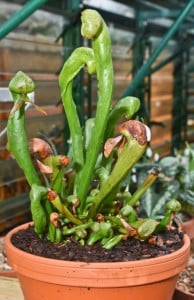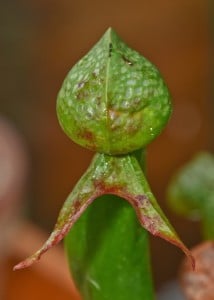Surely it’s too much to hope that carnivorous plants – which grow in sphagnum bogs – could be grown without peat? No: dream on…
Every once in a while, the dreams that so much of our gardening springs from come true. This abysmal, wonky winter, where I’m lashed almost daily by iced rain, and jostled in a gale, is taking its toll. I’ve watched as snowdrops – for the first time ever – are shredded by slugs, while hungry, inquisitive voles threaten tulipicide. Springs have popped up in new places, and the soil has lain utterly sodden for months. My garden and greenhouse are unusually empty for this time of year (a legacy of other commitments at key sowing times). Amid all this, I’ve felt the green ebbing from my fingers. But then it came, a light in the darkness, a spark that’s rekindled my gardening dreams. It’s amazing what a chance encounter on social media can do.

I’m struggling to recall how old I was when I grew my first Venus’ fly trap (Dionaea muscipula). I do remember, vividly, nudging hapless, half-stunned flies into its ‘jaws’, and watching them snap shut. It sowed the seed of a lifetime’s fascination with ‘carnivorous’ plants, which eke an existence in often nutrient-poor habitats by luring and trapping live food, primarily insects, which they then quietly digest (using, rather undramatically, enzymes). Since then, I’ve peered into the wondrous pitchers of nepenthes, while tending them in Kew’s tropical greenhouses, and I still dab gently at the sticky leaves of butterworts, which in summer dot the waterlogged uplands around my Snowdonian garden. But since those fly-trapping days, despite being enthralled by plants that eat animals, there’s one thing I have never done: grow them. I have admired carnivorous plants from afar, never once potting one up, even though my large, unheated greenhouse is ideal for growing many of them. The reason for my lifelong reluctance rests on one word: peat.
It was a tweet from David Morris, a Senior Reserves Ecologist with the RSPB, on the social media platform Twitter, that has rebooted my desire to grow carnivorous plants. His tweet of a cobra lily (whose delightful Latin name is Darlingtonia californica), appearing in the feed that brings together all tweets containing ‘#peatfree’, was all it took. Carnivorous plants, grown without nature-wrecking peat mined from drained, carbon-unlocking sphagnum bogs – surely not? I blinked. Twice. But there it was: a clump of this aptly-named insect-trapper growing merrily in a clay pot, with not a crumb of peat in sight. You don’t have to join Twitter to scan the hashtags, so even if you’re not signed up, try it out; you’ll find tips, pictures and snippets about peat-free growing, with everyone from balcony gardeners to big commercial growers all chipping in, and neatly sidestepping the pro-peat filters still dominating many gardening magazines.
I dropped everything and started looking up which of these bewitching and diverse animal-digesters might thrive in my sun-only-powered greenhouse. Sarracenia, the North American pitcher plant, which grows naturally in wetlands, including – you guessed it – peat bogs, looks like a great way to turn my fingers green again. I can’t wait to get going.

David’s tweet is the tip of a peat-free iceberg. For many years the carnivorous plant-growing mantra was that you must use a sphagnum peat-based compost for success (even the Royal Horticultural Society’s lagging website still claims that carnivorous plants ‘grow best in peat’). Somehow the irony of it being necessary to destroy the wild habitats in which these plants grow, so they can be grown in pots, eludes us; gardeners can at times be a selfish, ignorant and myopic clan. But now, a whole new and more earth-friendly world of growing is opening up. Specialist carnivorous plant growers and gardeners alike are busy experimenting with peat-free mixes, and they’re seeing impressive results.
But don’t rush out and start potting up in one of the modern peat-free composts on sale in garden centres. Although these are great for sowing and potting most plants, they’re too rich in everything that carnivorous plants don’t need: nutrients, a high pH, plus other additives found in modern composts. After getting mixed results with coir-based blends, David Morris now grows his cobra lilies and sarracenias successfully in a basic mix of equal parts of Melcourt Growbark Pine, perlite and lime-free grit. This open and free-draining mixture encourages extensive roots and vigorous growth, and virtually no moss grows on the compost surface. I look forward to mixing some up, and to trying out some of the peat-free composts specifically formulated for carnivorous plants. (Growbark comes, reassuringly, from the same stable as Sylvagrow peat-free compost, a ‘best buy’ in Which? Gardening’s latest trial of composts suitable for raising young plants, in January/February 2016. It’s also an all-round top performer in my own trials.)

As a conservationist, David believes that recognising a plant’s growing needs in the wild is key to understanding how to cultivate it, and this applies equally to those growing in peatland or similar habitats. However, just because a plant grows in a peat bog doesn’t automatically mean it must have sphagnum peat at its roots to flourish; you just need to find a growing medium that mimics the conditions the plant encounters naturally. David’s peat-free cobra lily makes the point rather well, dealing the ‘must have peat’ mantra a fatal bite.
I’m cock-a-hoop that a fortuitous spark of shared enthusiasm on social media has unlocked a suppressed desire to grow plants for which I’ve long hankered. But carnivorous plants going peat-free is the tip of just one of many bigger icebergs. More and more commercial growers of trees, shrubs, bedding plants, perennials, alpines, vegetables, fruit and herbs have switched (or are switching) to peat-free cultivation; some did it years ago, but are only just ‘coming out’. Please keep on coming; gardening and nature need you.
My tip for commercial growers big and small is to let your plants (whether they eat other things or not) wear their peat-free status as a badge of ecological, nature-savvy honour. It might even win you new customers, long repelled by peat, who believe that gardening shouldn’t come at any price.
Text © John Walker. Darlingtonia images courtesy of David Morris. Sarracenia purpurea: Andre de Saint-Paul/Wikipedia
Find John on Twitter @earthFgardener


